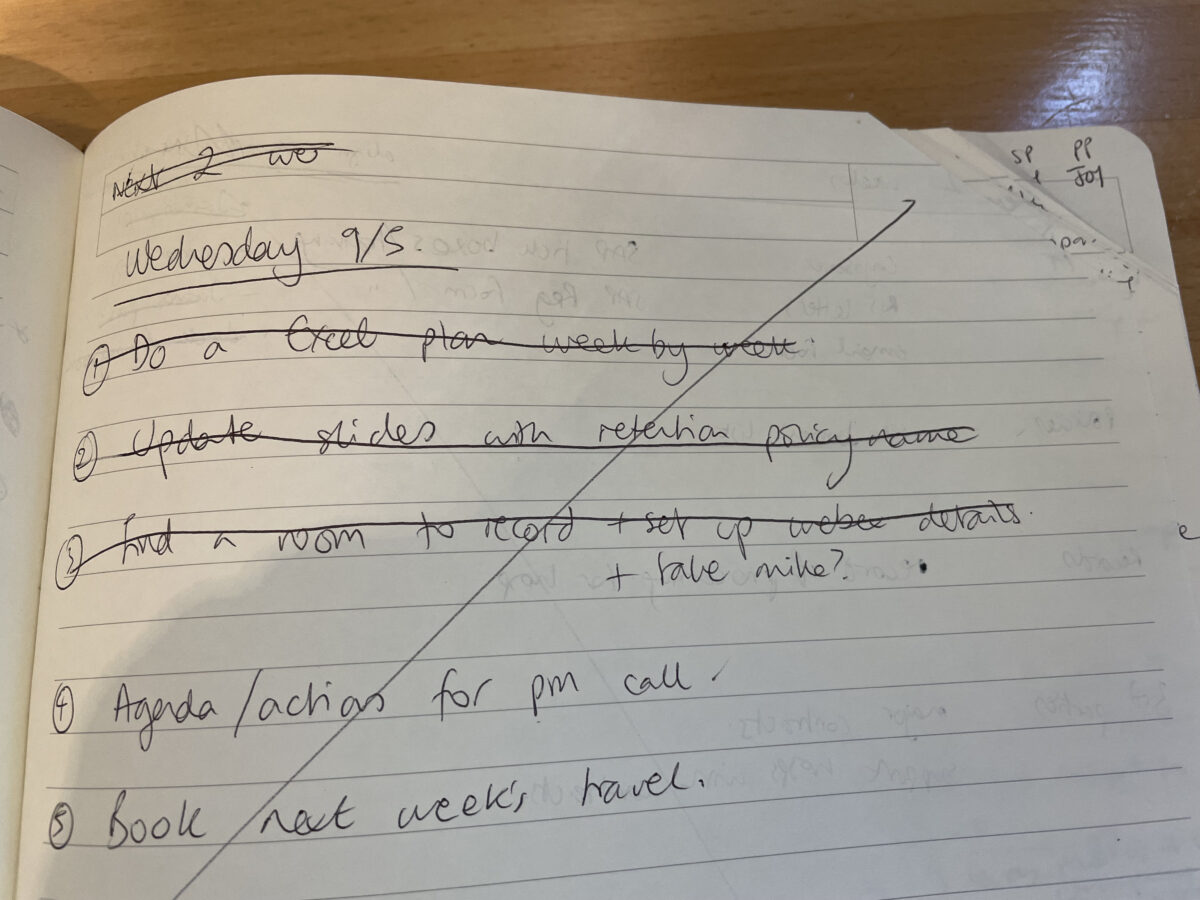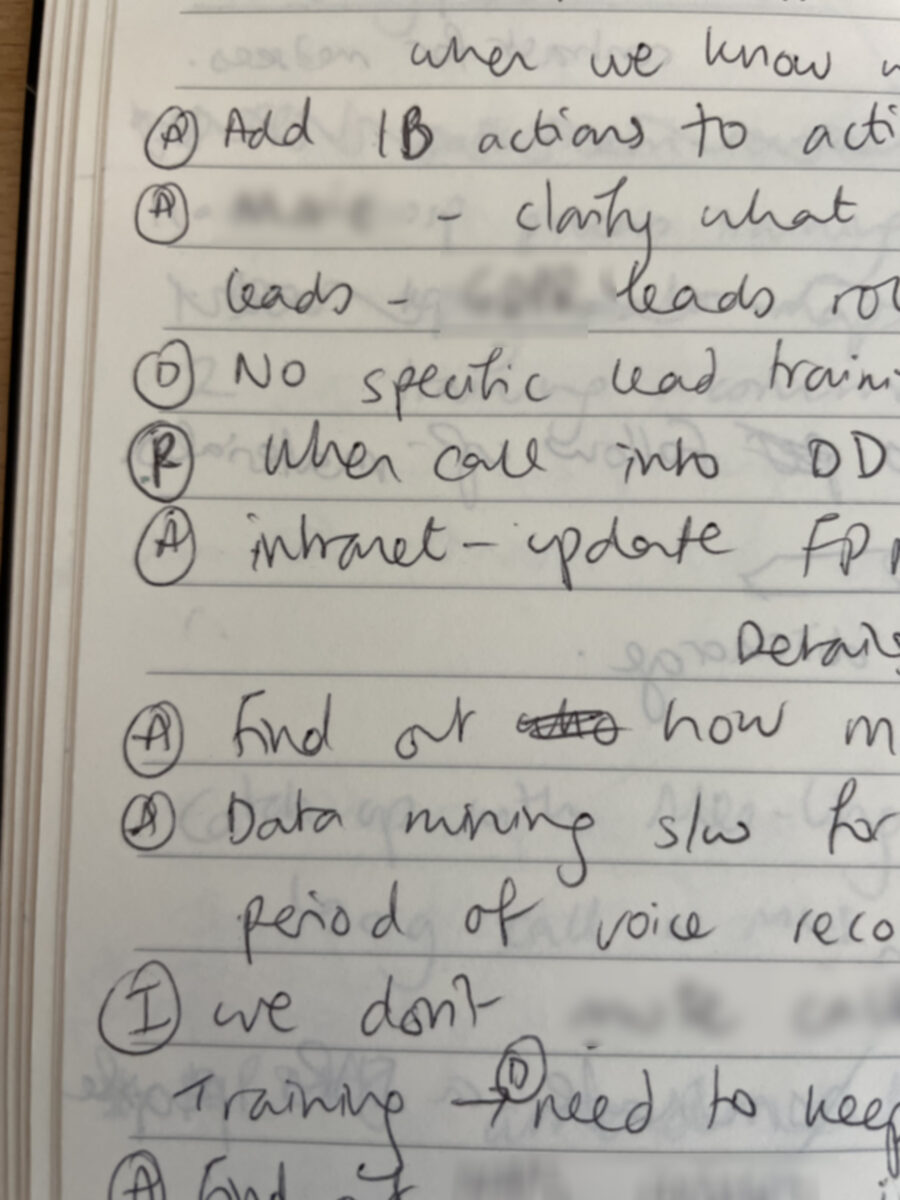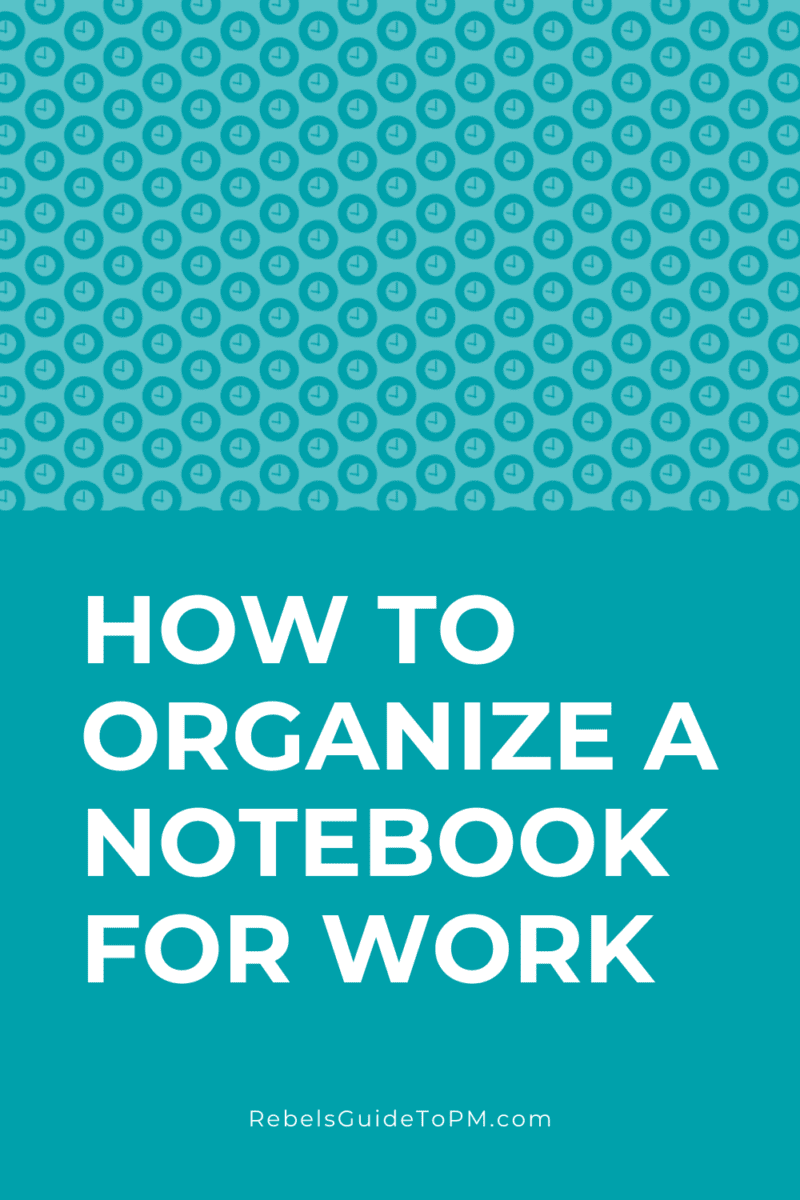10 Easy ways to organize a notebook for work
This blog is reader-supported. When you purchase something through an affiliate link on this site, I may earn some coffee money. Thanks! Learn more.
Whether you are hybrid, home-based, or completely in the office, notebooks are a part of many people’s working life. But how do you organize notes in a notebook?
A lot of it is personal preferences but there are also plenty of good practices for managing daily tasks in your work environment. If you are looking for ways to keep a notebook organized, you’re in the right place!
In this article, I’ll share my best notebook organization hacks and some simple steps for figuring out how to turn your notebook into a personal planning hub.
Ready? You’re never going to lose your notes again!
Why use a notebook
When so much work is digital and virtual these days, what’s the value in having a notebook? I use paper notes alongside computer-based To-Do lists and action trackers because:
- The notebook is right there in the morning and I can see my priorities before firing up my PC
- I can jot down a note whenever I want because it’s always open and available – no need to open another app
- I lose pieces of paper if I write notes on them
- It’s portable so it goes with me where my laptop doesn’t go
- Sometimes I just need screen-free time.
For me, a notebook is a quick way to be better at time management every single day. Jotting things down saves me time and keeps my work projects on track.
I’ve been organizing notebooks and refining ways to keep a notebook organized my whole working career (and before that – for college and university notes).
I’ve read dozens of books on time management and personal productivity and researched many techniques for work organization during the process of researching my own books. Managing Multiple Projects has a whole chapter on personal productivity.
So I’ve pretty much got my notebook organization system down.
Let’s dive in.
How to organize a paper notebook
First, let’s think about how you’re going to make this work for you. I can share my best tips for notebook organization (and I do, below) but everyone’s brain is different. It’s really important to personalize how to organize your notebook notes so they work for you.
Here’s a great way to get started.
1. Work out what your notebook is for
What are you going to use your notebook for? It could be:
- Meeting notes
- Daily jottings
- Brainstorming and problem solving
- To do lists
- Recording actions from team meetings
- Acting as your daily or monthly calendar (you can get books pre-printed with calendar pages in)
Or anything else.
I’m assuming in this article that you are using it as a work notebook. I would recommend that if you want to manage family and personal notes that you do that in a separate book. I have a separate notebook in the kitchen for meal plans.
Keep your work notes in one place because your notebook is to make life easier for future you.
It’s there because you want to record or remember something.
2. Decide how you are going to use it
When you’re thinking about how to use a notebook for work, the next step is to think about how and when you are going to use it. Is it going to travel around with you or mainly be on your desk?
Is it just for you or are you expecting other people to look at it? In my experience, people don’t share notebooks. Unless it is for something like recording test results or logging who goes in and out of the building, sharing client feedback or writing up a summary of the day for a handover to the next duty manager – mostly your notebook is going to be just for you.
That’s great news because you can set it up how you want and no one else needs to understand the system! Whether you want to use lists or mindmaps (or both), the choice is yours.
How I use my notebook
Mainly my notes are for To-Do lists, meeting prep, and thinking plus ad hoc notes for meetings. It’s often a mess, but it works for me.
I have two styles of notebooks. One I take to project management conferences is full of dense, tightly-packed pages of notes from talks, takeaways, and learnings. One I use for daily work is unstructured and pretty messy, with the pages crossed out when I’m done.
3. Choose the right notebook for you
Now you know how it is going to be used, you can pick what kind of notebook to use. What size and type will you need? How much space? Lined or blank pages? There are so many different formats to choose from.
If your notebook will travel around with you, choose something small and preferably with a hardback, durable cover so it doesn’t get bashed up in your bag.
If it is going to mainly sit on your desk, I would recommend a spiral-bound book so you can keep it open with the pages lying flat. I use Pukka Pads because they do exactly that.
If you’re anything like me, you won’t want to spend a lot on something when there is a stationary cupboard with the ‘standard’ office notebook selection in. These are normally inexpensive, spiral notebooks in my experience. And they do the job just fine.
Use what you have – you can make anything work within reason.
While I do love a Moleskin-style notebook, I only tend to use them for ‘fancy’ occasions at work when either I’m trying to impress (e.g. job interview) or I’m going to a conference. However, I wouldn’t spend a lot of money on a notebook. Most of my nicest ones have been given to me as gifts.
Personally, I draw the line at anything smaller than A5 except in certain circumstances such as a non-work book for making personal notes and journal entries while I’m on holiday.
Tip: If you are using the same style notebook as everyone else in the office, put your name or a sticker on the front so you know it’s yours.
Tips for organizing a notebook
So you’ve got a blank notebook and are ready to get going? Here are my top notebook organization ideas for work, in no particular order.
1. Cut the corners
Make it easy to flip to the ‘working’ page of your notebook by snipping the corners of every page that is done.
I normally draw a big line through the page when I’m finished with it. That could be when I’ve transferred the notes to another tool, or completed the actions or whatever. I also snip the corner off the page or fold it over so I can easily flick to the next page with work on.
This makes it really easy to find what my current activities, tasks and notes are without having to keep flicking back and forth.
If you take nothing else away from this article, cutting the corners is my number one tip for how to use a notebook effectively!

2. Put the To Do list at the back
Another tip to stop you flicking back and forth in your notebook is to keep important things on a To Do list at the back.
Then you can always find it, regardless of how many notes and doodles you do.
3. Put important information on the inside front cover
Write important, project-related information inside the notebook’s front cover. Again, this is a tip to help keep your notebook organized and make it easy for you to find stuff again.
This could include:
- Cost codes, timesheet codes or project codes
- Important telephone numbers
- Instructions on how to change your voicemail (can you tell that’s a real example from inside my book?!)
Obviously don’t write down passwords.
4. Put a date on the front
You’ll get through a lot of work notebooks in time, so put the start date on the front cover or one of the first inside pages so you know what time period this book covers.
I also put the date at the top of each new page, especially when the work on the page is specifically relevant to a meeting.
5. Organize the inside
If it works for you, section the inside (with sticky tabs) and use page numbers and indexing to organize your thoughts.
I don’t use page numbers in my books because they are free-flow for my notes and tend to be a chronological representation of what I was working on at the time. But if you are going to be more structured, here is what some of my colleagues do:
- Leave a page at the front for the table of contents or keep a page at the back for the index
- Add page numbers to each page
- Mark where things are in the notebook as you go.
This technique works well when you have split your notebook into sections, for example one per project, or one per quarter. I don’t section my work because as a project manager, I find much of my work overlaps. One conversation about one project easily spills over into a conversation about another. I don’t want to say, “Hold on, let me find the right page to write that down.”
If you don’t want to number and structure, an alternative option is to have a different notebook for each project or to use sections — I don’t do it, like I said, but it is a valid choice.
6. Use sections
Split your notebook into sections. Sections could be:
- Weekly goals and objectives (or monthly/annual goals)
- Trackers for habits e.g. drinking water, gratitude
- Lists e.g. team birthdays.
Use sticky notes or sticky tabs to section off the book and make it easier to find the right page when you need it.
You can be even more structured by following the bullet journal method. There’s a lot to cover with that technique so I have a separate article about using a bullet journal system.
7. Mark notes with action symbols
When I look back at my different lists and notes, I want to easily pick up the key points. I learned this tip from my first manager, Jo, at American Express.
She put an A in a circle next to anything that was an action. Genius. I’ve taken this a bit further and use the following, in circles to help them stand out in the notes:
A: Action – for specific tasks to be done
D: Decision – normally to be transferred to a decision log or confirmed on email so no one can forget that we made it.
R: Risk – to be transferred to the project risk log and something done about it.
I: Issue – to be transferred to the issue log and flagged with whomever is going to be able to do something about it.
Star – something important. Normally something that has to be done today.

8. Schedule time to rewrite it
I make time to rewrite the important lists in my book (the actions) on a regular basis. It isn’t strictly necessary, but it helps me clear my mind and focus on what is still to do.
I re-write my ‘current’ pages regularly, grouping topics together by project.
However you use your notebook, I would recommend allocating some time on a regular basis to go through it and tidy it up. Mark tasks as complete, transfer notes to other tools, re-write lists. Just refresh yourself on what is in there and check it is still working for you.
You could do it at the end of the day, but I find that too frequent. I want to spend less time on reviewing it than actually using it, so I tend to review my notebook once a week, so I’m ready for next week. Either a Friday or a weekend works for me.
9. Use colors
I rarely use colors to highlight things in my notebook, but I’ve worked with plenty of people who bring a whole pencil case to meetings and change pens regularly to write in different colors.
I couldn’t be bothered with that, personally, but if it works for you, keep a few colored highlighters or pens in your bag. Underline or box important notes in a different color, or switch pens to write in different colors.
10. Make it fit with your online tools
Your notebook should be part of a whole productivity and task management system. It should fit alongside your online tools.
For example, use MS Teams to track your team actions (actually, we use Infinity), or an action log on a shared drive, and use a notebook for your personal actions.
Your system should work in the round. No one in your team should be waiting to be told what to do because you wrote it down in the wrong place.
Keep it simple
Work notebook organization should be simple. If you create a system that is too difficult to stick to, then you won’t stick to it.
For example, I don’t use sections in my notebooks because I don’t know how much I want to put in each section and I’m very much against waste.
I don’t want to start a new notebook knowing there are plenty of blank pages left in one section – but equally I don’t want to carry two notebooks around so I can fill up the sparse section before I ditch the book completely.
I’m a ‘single notebook at a time’ kind of person when it comes to daily work.
Flex and improve as you go
Remember, the way you organize your work notebook can evolve over time. Switch up how you use your notebook as your needs change.
Check out a few different ways to organize notes and see what works for you. Customize as you grow and your organization system has to meet different demands. It’s fine: none of this is set in stone.
The ideas, tips and hacks in this article will give you a good starting point for making your own notebook productivity system and making it work for you.
But there is no one perfect system. As long as it works for you, it’s good.
Notebook Resources
Check out my recommended resources for using notebooks at work.

